Georgina Campbell's Cookery Feature - Neven Maguire's Perfect Irish Christmas
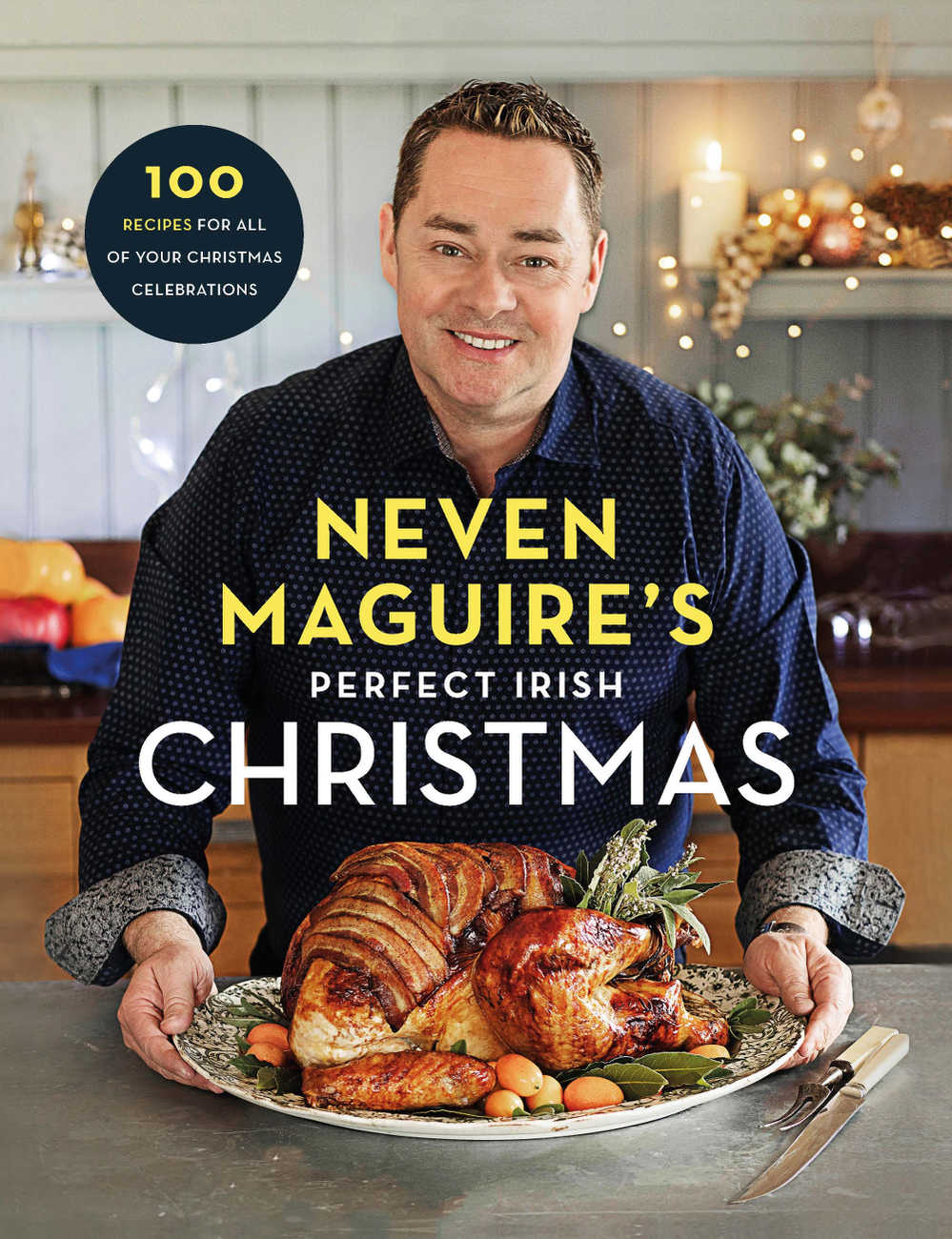
Neven Maguire’s Perfect Irish Christmas is published by Gill Books, price €22.99.
A new book from Neven always causes a stampede in the book shops and this one, in particular, is destined to be a classic. All the Christmas essentials are there, with everything for the ‘big dinner’ set out reassuringly clearly for confident reference - and plenty of options on the traditional dishes, including all the accompaniments, and alternatives for those who want to do something different.
The turkey causes the most worry - don’t panic, just follow Neven’s calm step-by-step guide below - but it isn’t actually the most challenging thing about cooking the traditional Christmas dinner for a crowd.
It’s all the sides and bits and pieces that can be most challenging, especially in a small kitchen, and Neven has plenty of ideas to make life easier. For example, although the perfect roast potatoes and other vegetables and side dishes are given in the book, there are also suggestions for alternatives that are easier to manage for large numbers.
I especially like the Celeriac & Sweet Potato Boulangère and the Braised Red Cabbage with Pomegranate recipes, given below, because they are forgiving dishes and take a lot of the last-minute stress out of cooking the vegetables.
The boulangère is an interesting dish - a good variation on the usual spuds, and a great deal easier on the cook than roast potatoes. Similarly, sprouts may be more traditional, but red cabbage is the one brassica vegetable that can be cooked ahead and it’s very festive with its pretty pomegranate garnish.
Most people like to have a proper starter on Christmas Day, but I’ve always felt that nibbles handed with drinks beforehand are much better, and party recipes like Neven’s Blinis with Smoked Salmon are perfect for that, or any other get together over the Christmas period - one of the best things about this book is that it covers the whole festive season - and with 100 recipes to choose from, there are plenty of delicious and very do-able dishes for every conceivable occasion. All round a great reference, and really reliable as ever.
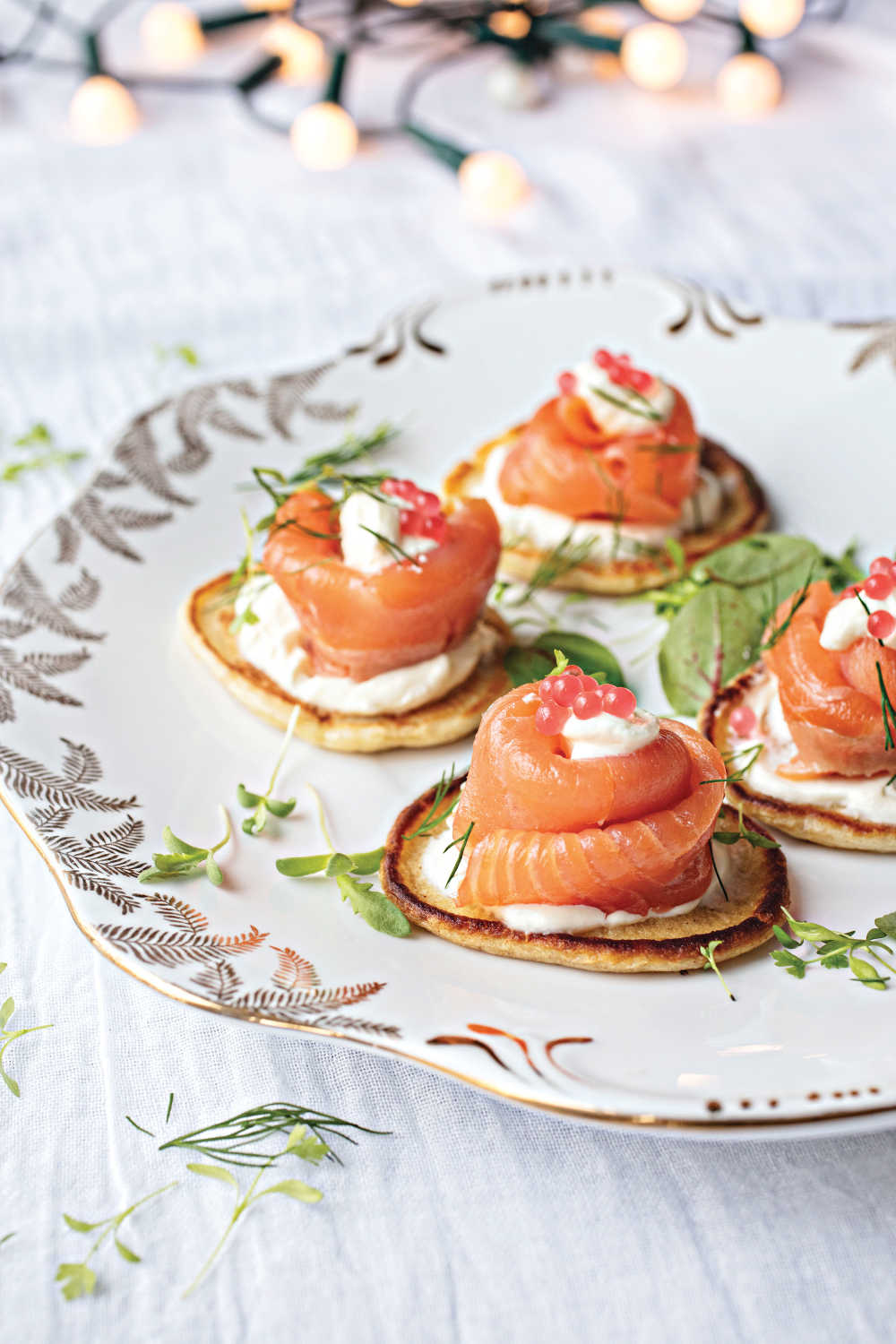
Blinis with Smoked Salmon
Blinis are originally from Russia and are perfect topped with sour cream, smoked salmon, dill and whatever caviar you can afford! Of course, if you don’t have time to make your own, most supermarkets stock a range of ready-made cocktail-sized blinis, particularly during the festive season.
Makes 30 – 40
225g (8oz) smoked salmon slices
200ml (7fl oz) sour cream
1–2 tbsp chopped fresh dill
fresh micro herbs, to garnish
salmon caviar, to serve (optional)
For the blinis:
175g (6oz) plain flour
50g (2oz) buckwheat flour
1 tsp fine sea salt
1 x 7g sachet of fast-action dried yeast
225ml (8fl oz) milk
200ml (7fl oz) crème fraîche
2 large eggs, separated
groundnut oil, for greasing
40g (1½oz) butter
1 First make the blinis. Sift the flours into a large bowl and add the salt and yeast. Heat the milk and crème fraîche to lukewarm in a medium pan. Whisk in the egg yolks, then add the flour mixture. Mix into a dough, then transfer to an oiled bowl and cover with cling film. Leave to rise for 1 hour in a warm place, until doubled in size.
2 When the dough has doubled in size, whisk the egg whites in a separate bowl, then fold them into the dough and leave to rise for another hour.
3 When you’re ready to cook the blinis, heat a large non-stick frying pan or flat griddle pan over a medium heat and smear with a little of the butter. Ladle tablespoons of the blini mix into the pan, then add another heaped teaspoonful to each one to make the middle thicker. Turn when firm and cook until lightly brown. Leave to cool on a wire rack.
4 Pile up the slices of smoked salmon into a stack (or you could shape into rosettes if you prefer). Using a very sharp knife, cut across the stack to make thin strips. Smear a little of the sour cream on each blini and arrange the smoked salmon on top. Add a tiny dollop of the sour cream to each one and garnish with the dill and micro herbs and a little caviar (if
using). Serve at once.
Roast Turkey with Streaky Bacon
This is the easiest way to roast a turkey, and fortunately, for many people it’s also the best. Forget about having the time to brine it or trying to turn it over while it cooks – this method is absolutely foolproof.
Serves 10 – 12
1 x 4.5–5.4kg (10–12lb) oven-ready turkey (preferably free-range), at room temperature
1 quantity stuffing (optional)
100g (4oz) butter, softened
15–18 rindless streaky bacon rashers
sea salt and freshly ground black pepper
small bunch of fresh herbs (to include parsley, sage and bay leaves), to garnish
1 Preheat the oven to 190°C (375°F/gas mark 5).
2 Turn the turkey breast side up and pack the neck cavity loosely with stuffing (if using), then tie the top of the drumsticks together with string. Smear with most of the butter and season generously, then place the bacon over the breasts to cover them completely. Weigh the turkey to calculate the required cooking time, allowing 20 minutes per 450g (1lb) plus 20 minutes extra.
3 Lay a large sheet of foil lengthways over a large roasting tin, leaving enough at each end to wrap over the turkey, then lightly butter the foil. Repeat with another sheet of foil, but this time laying it across the tin. Place the stuffed turkey in the centre of the foil, breast side up, then wrap loosely to enclose but still allowing air to circulate around the turkey.
4 Put in the oven and cook according to your calculated cooking time, carefully unwrapping and basting the turkey every 40 minutes. For the final hour, fold back and remove the foil, keeping the ends of the drumsticks still covered in foil to prevent them from burning. Baste well and return to the oven. The turkey should be a rich, dark brown colour. To make sure it’s cooked, insert a fine skewer into the thickest part of the thigh – the juices should run clear, but if they are still pink, return the turkey to the oven and check again every 15 minutes, until you are happy that the turkey is cooked right through. Remove from the oven and transfer to a serving platter. Cover with foil and leave to rest in a warm place for 10 minutes (up to 30 minutes is fine).
5 To serve, garnish the turkey with the bunch of herbs in the neck cavity and bring to the table. Carve into slices and arrange on warmed plates with all the trimmings.
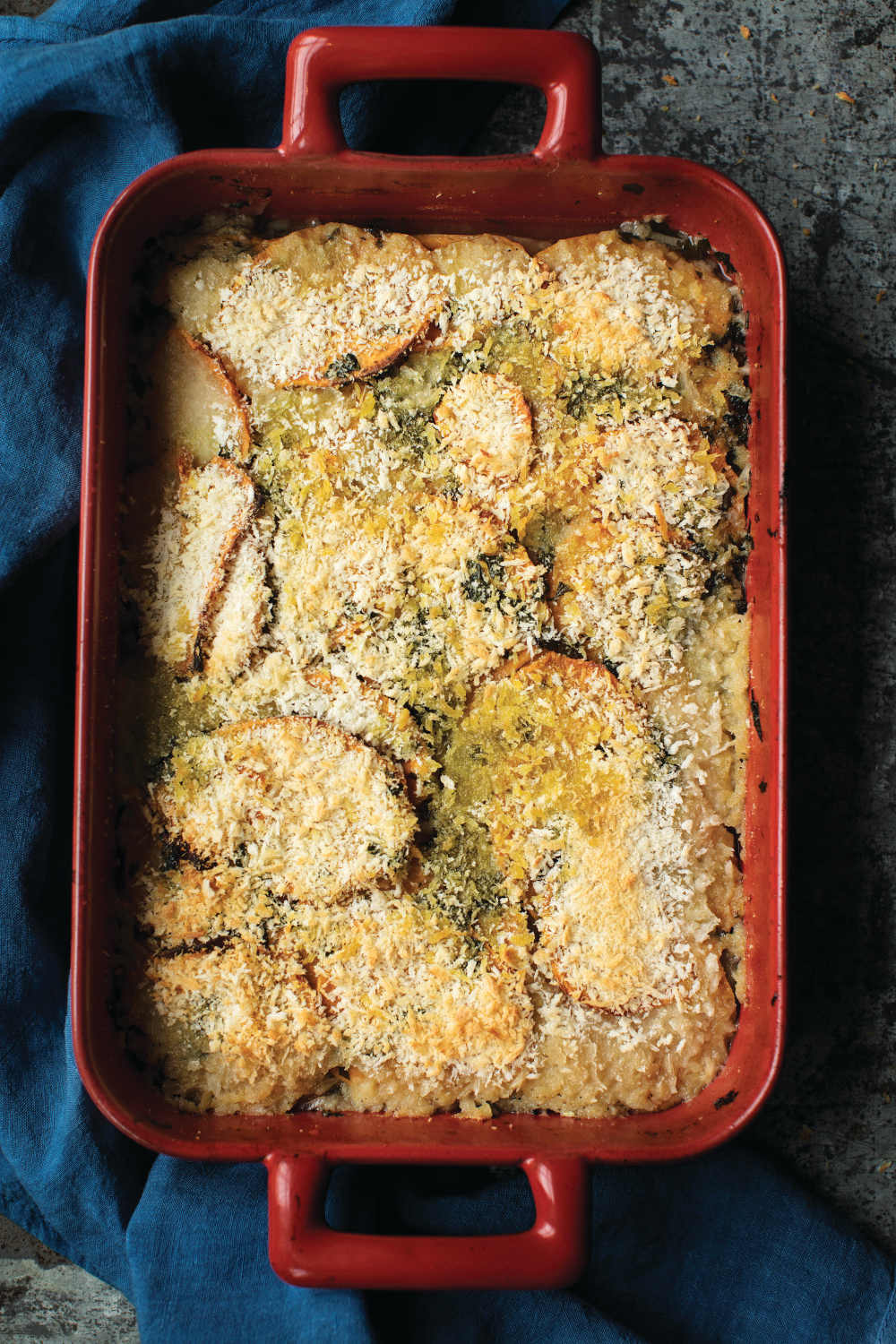
Celeriac & Sweet Potato Boulangère
This hassle-free dish is perfect for the Christmas table. The layered up celeriac, sweet potatoes and onions absorb all the stock. It can be made in advance and left to cool completely before covering with cling film and storing in the fridge for up to three days before you want to use it. Reheat covered with tin foil in a preheated oven set to 180°C (350°F/gas mark 4) for 30 minutes, until piping hot.
Serves 8 – 10
2 tbsp rapeseed oil, plus extra for greasing
3 onions, thinly sliced (on a mandolin is best)
3 garlic cloves, thinly sliced
2 tbsp roughly chopped fresh flatleaf parsley
1 tbsp chopped fresh mixed herbs (use a mixture of sage, rosemary
and thyme)
1kg (2¼lb) sweet potatoes, peeled and thinly sliced (on a mandolin is
best)
1 large celeriac, peeled and thinly sliced (on a mandolin is best)
900ml (1½ pints) chicken or vegetable stock
50g (2oz) butter, diced
25g (1oz) stale white breadcrumbs (sourdough is best)
sea salt and freshly ground black pepper
1 Preheat the oven to 200°C (400°F/gas mark 6).
2 Heat the oil in a frying pan set over a medium heat, then sauté the onions, garlic and herbs for 10 minutes, until soft and lightly golden. Season to taste.
3 Layer the sweet potatoes in a large baking dish with the onions and celeriac. Season each layer as you go and finish with an attractive overlapping layer of the sweet potatoes. Pour over the stock and top with knobs of butter.
4 Rub some foil with oil and place it over the dish, oil side down, and seal tightly. Bake in the oven for 45 minutes, then remove the foil and press the potatoes down with a fish slice. Scatter over the breadcrumbs and bake for another 15–20 minutes, until golden. Serve at once or leave to cool completely before covering and storing in the fridge until needed
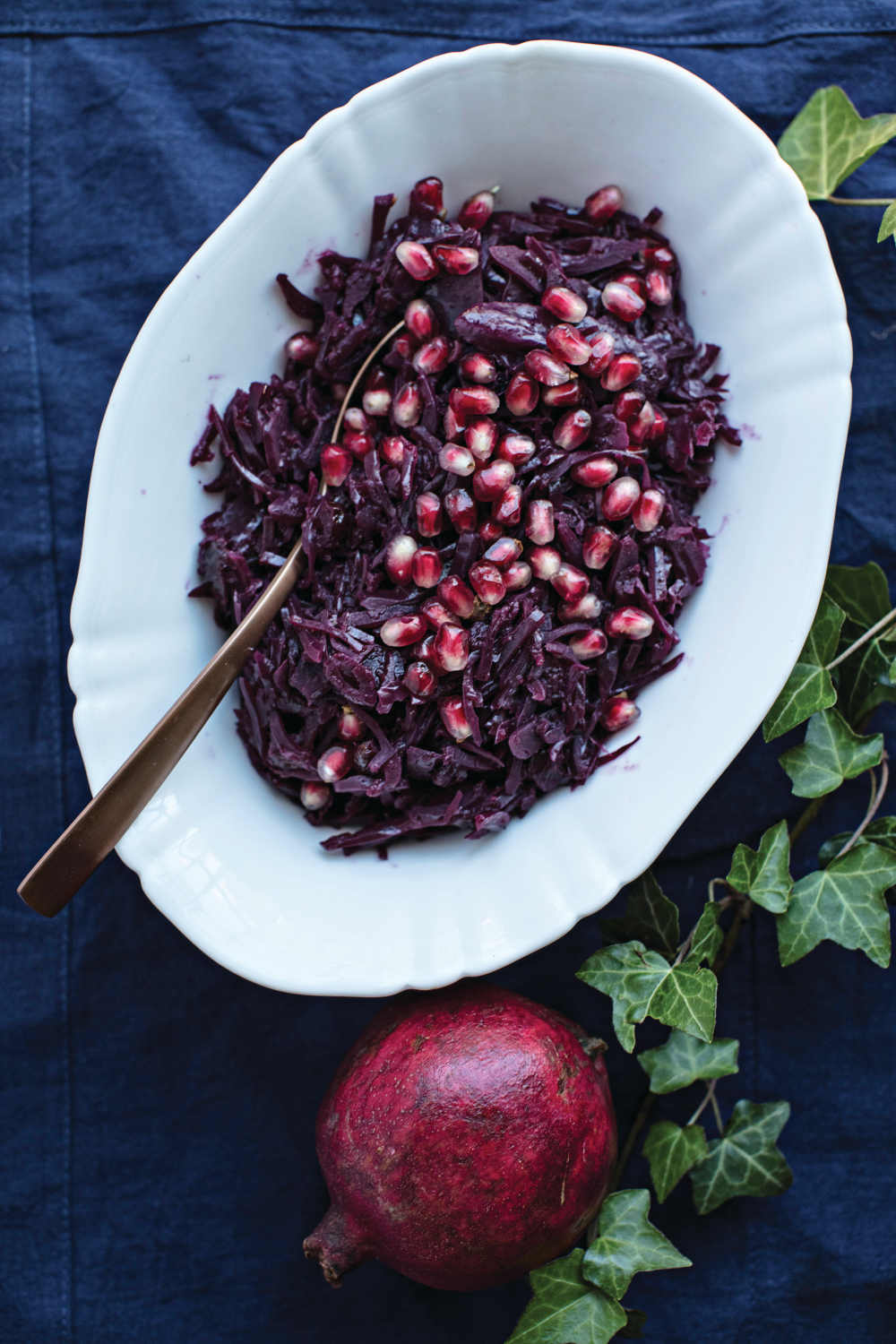
Braised Red Cabbage with Pomegranate
This is an ideal vegetable to prepare in advance and is excellent with turkey, ham or goose. It will keep for up to a week in the fridge covered with cling film in a non-metallic bowl. It also freezes very well – simply pop into medium-sized freezer bags and leave to thaw out before reheating gently, either on the hob or in a casserole dish with a lid in the oven.
Serves 8 – 10
4 tbsp duck or goose fat (from a jar or left over from a roast) or 2 tbsp
rapeseed oil
1 red cabbage, trimmed, cored and finely shredded
2 red onions, thinly sliced
1 large Bramley cooking apple, peeled, cored and grated
100g (4oz) dried cranberries
300ml (½ pint) red wine
300ml (½ pint) pomegranate juice
6 tbsp redcurrant jelly
4 tbsp red wine vinegar
1 tsp mixed spice
½ tsp ground cinnamon
½ tsp ground ginger
good pinch of ground cloves
sea salt and freshly ground black pepper
pomegranate seeds, to garnish (optional)
1 Melt the duck or goose fat in a very large heavy-based pan set over a medium heat, then tip in the red cabbage and onions. Sauté over a medium-high heat for about 5 minutes, until just beginning to soften.
2 Stir in the apple and cranberries, then add the red wine, pomegranate juice, redcurrant jelly, red wine vinegar and spices. Season to taste. Bring to the boil, stirring occasionally, then reduce the heat and simmer for about 1 hour, stirring every 20 minutes, until the cabbage is meltingly tender.
Transfer to a warmed dish and garnish with pomegranateseeds (if using) to serve.
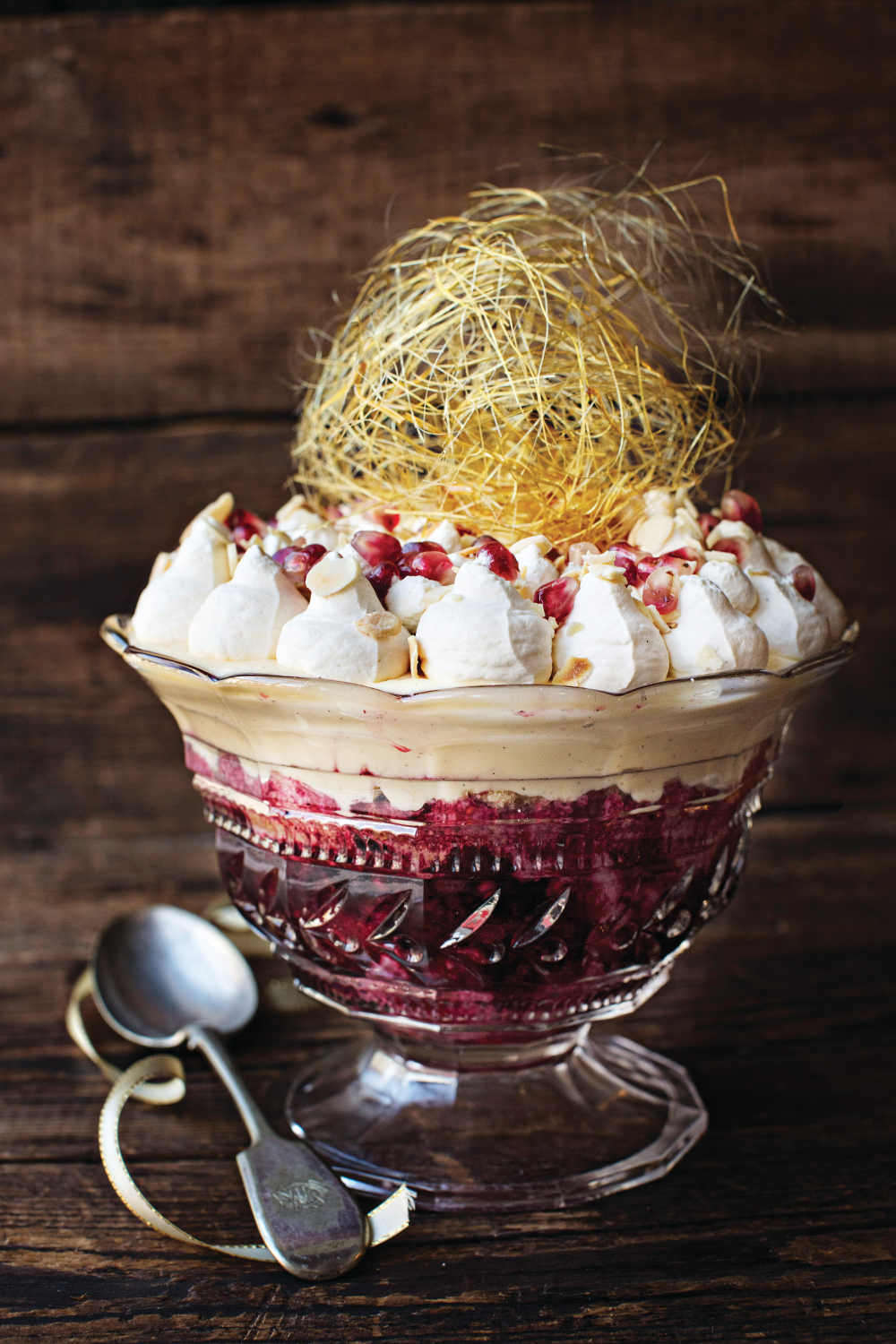
Vera’s Sherry Trifle
This is one dessert that I can clearly remember from my childhood – it probably even enticed me to be a chef. My mum always made this for special occasions and I just loved helping, especially with the cleaning of the bowls… Now I like to decorate the top with pomegranate seeds to make it sparkle like jewels.
Serves 6
200g (7oz) Madeira cake, broken into pieces
300ml (½ pint) cream
toasted flaked almonds, to decorate
pomegranate seeds, to decorate
spun sugar, to decorate (optional)
For the custard:
300ml (½ pint) milk
100ml (3½fl oz) cream
½ vanilla pod, split in half lengthways and seeds scraped out
5 egg yolks
4 tbsp caster sugar
2 tsp cornflour
For the fruit:
100ml (3½fl oz) sweet sherry
100g (4oz) caster sugar
½ vanilla pod, split in half
lengthways and seeds scraped out
1 x 500g (18oz) bag of frozen fruits of the forest
1 To make the custard, put the milk, cream and vanilla pod and seeds in a heavy-based pan set over a gentle heat and cook until it nearly reaches the boil – but don’t allow to boil.
Meanwhile, put the egg yolks, sugar and cornflour in a large bowl and whisk together until pale and thickened.
2 Remove the hot milk and cream mixture from the heat and slowly whisk it into the egg mixture through a fine sieve until smooth. Discard the vanilla pod and pour back into the pan, then set over a gentle heat. Cook, without allowing it to boil, until the custard coats the back of a wooden spoon, stirring continuously. Remove from the heat and leave to cool, covered with a piece of cling film pressed directly on the surface of the custard to prevent a skin from forming on top.
3 Meanwhile, prepare the fruit. Put the sherry in a large pan with the sugar and vanilla seeds and bring to the boil. Reduce the heat and simmer for 4–5 minutes, until syrupy, stirring occasionally. Stir in the frozen fruits of the forest and set aside until cooled, stirring occasionally. The fruits should defrost naturally in the hot syrup but still hold their shape.
4 Scatter the Madeira cake over the base of a 1.5 litre (2½ pint) glass serving bowl. Spoon over the fruit and cover with the cooled custard. Chill for 1 hour, until the custard sets a little firmer, or up to 24 hours is fine.
5 When ready to serve, whip the cream in a bowl until you have achieved soft peaks. Put spoonfuls on top of the custard, then gently spread with a palette knife or the back of a spoon to cover the custard completely (or you can use a piping bag). Sprinkle over the toasted flaked almonds and pomegranate seeds and decorate with some spun sugar if liked, then place straight on the table to serve.





There are currently no comments
Leave a comment
Not a member? Register for your free membership now!
Or leave a comment by logging in with: